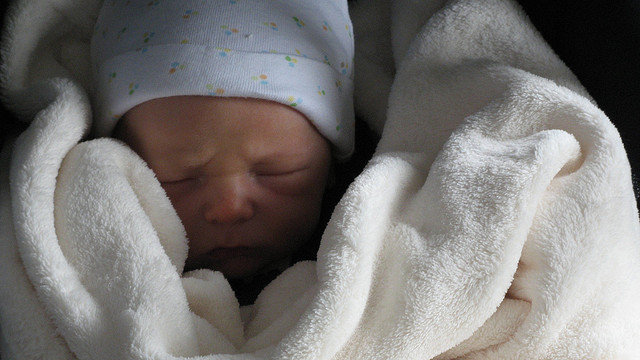This piece was originally published over at Moms Clean Air Force [2].
When my oldest son was born he was showered with all sorts of wonderful gifts from friends and family. One of our favorite presents was a bright red fleece blanket with his name monogrammed in big white letters on one of the corners.
This adorable and durable blanket stayed with my son for many years. He slept with it, rolled around on it and chewed it while teething. After many washes and years gone by, it’s now tucked away in a “save” box somewhere deep within my attic.
Today, as I continue the tradition of giving fleece blankets to many of the new babies in my life, I wonder if these blankets are truly safe.
Could there possibly be bisphenol-A (BPA) lurking in those cuddly, soft gifts?
Is There BPA in Fleece?
Fleece is made from post-consumer recycled (PCR) plastic soda bottles and other discarded plastic. That’s right-fleece is made from recycled plastic!
Here’s how the question of BPA (bisphenol A) [3] in fleece comes into play. BPA [4] is a chemical used in the production of plastics and many other products. BPA has been linked to a variety of health problems such as reproductive disorders, diabetes and cardiovascular disease.
Since fleece is made from plastic components, the question of BPA in our fleece garments becomes a valid concern.
There’s good news and caution for consumers.
You don’t have to worry about baby’s fleece — or your own — when it comes to BPA. As Dr. Sarah Vogel, author of Is It Safe? BPA and the Struggle to Define the Safety of Chemicals, [5] explains:
“BPA is not used in plastics used to make soda bottles. The kind of plastic it’s used in, polycarbonate, is too hard for that purpose and too expensive. Polycarbonates are not recycled in most municipalities as they fall into category 7 which is ‘mixed’. So they end up in landfill and BPA has been detected in landfill leachate.
The epoxy resins BPA is in are used to coat metals, like food cans. BPA has been found in recycled cardboard –most likely because of its use in carbonless paper (like cash register receipts) that is in the recycled paper mix. It would be quite challenging to remove it from the recycling process, I suspect.
I worry more about the food cans. There is evidence that you can significantly reduce exposure to BPA by removing food cans from the diet, which demonstrates the importance of that route of exposure.”
I decided to look towards the top sellers of fleece products for some answers: Patagonia [6] and L.L. Bean [7]. Both companies confirmed that they use post-consumer recycled (PCR) plastic soda bottles to make their fleece.
Patagonia
Patagonia has many green initiatives in place — including recycling used soda bottles, unusable manufacturing waste and worn our garments (including their own) into polyester fibers to produce many of their clothes. One of my favorite Patagonia programs is something called Common Threads [8] where they take back old outdoor garments (including their own!) for recycling into new fibers.
Good news: Patagonia confirmed that there is no BPA in their fleece.
L.L. Bean
L.L. Bean [7] responded similarly when asked about BPA lurking in their fleece products.
“The majority of our Trail Model Fleece program contains up to 85% recycled materials, mostly old soda bottles. Our recycled materials do not contain any BPA at all.”
L.L. Bean confirmed there’s no BPA in their fleece. But as I suspected…
“All of our kids’ sleepwear is flame retardant as required by the US Federal government — all of the fabric in our kids’ sleepwear meets federal safety requirements for children’s sleepwear.”
Although there are many more makers of fleece products out there, a confirmation from both of these fleece clothing retailers is a good indication that the majority of fleece doesn’t contain BPA.
The Environmental Impact of Fleece
Along with the good news that BPA isn’t hiding out in our fleece gear comes another concern about fleece and its impact on the environment.
A study [9] found that microscopic plastic debris from washing clothes is accumulating in the marine environment and could be entering the food chain. Some of our synthetic clothes are made of PET or polyethylene terephthalat [10]e. PET is a member of the polyester family of polymers, which are spun to make fabric which can release up to 1,900 tiny fibers [11] each time they’re washed! PET does not biodegrade, and these microplastics are being ingested by marine life.
Fortunately BPA in fleece products doesn’t pose a problem, however there are plenty of unregulated toxic chemicals remaining in products found on the shelves of our stores.
Take action! It’s time to put the pressure on. It’s time to take the burden away from the consumer and place it where it belongs – with retailers and industry. We need legislation in place that will strengthen the way our government regulates toxic chemicals by requiring more thorough health testing of products BEFORE these chemicals end up in the bodies of our children.
If you agree parents shouldn’t need to be detectives or have a PhD in toxicology to know that their children are safe from toxic chemicals, please head over to Moms Clean Air Force to sign HERE [12].
photo credit: dan.danowski [13] via photopin [14] cc [15]
